If you are considering moving to Italy and aren’t sure where to start, our “Best Places To Live In Italy” list will definitely help you gather ideas and start your research.
Although we think of Italy as a wholly blissful country, there are big variations in lifestyle and environment. Depending on whether you want to live in the countryside or prefer cities, your best place might be different from what other people prefer.
Here’s our list of the top locations in Italy, including cities, rural and coastal destinations:
- Milan
- Lake Como
- Bolzano
- Trento
- Brescia
- Liguria
- Padua
- Pisa
- The Chianti
- The Amalfi Coast
- South Sardinia
- Rome
1. Milan – where fashion meets history
Milan is very diverse and is as lively and cool as a fashion capital should be.
However, Milan is primarily a working and business city, so it offers all the perks and drawbacks that come with this.
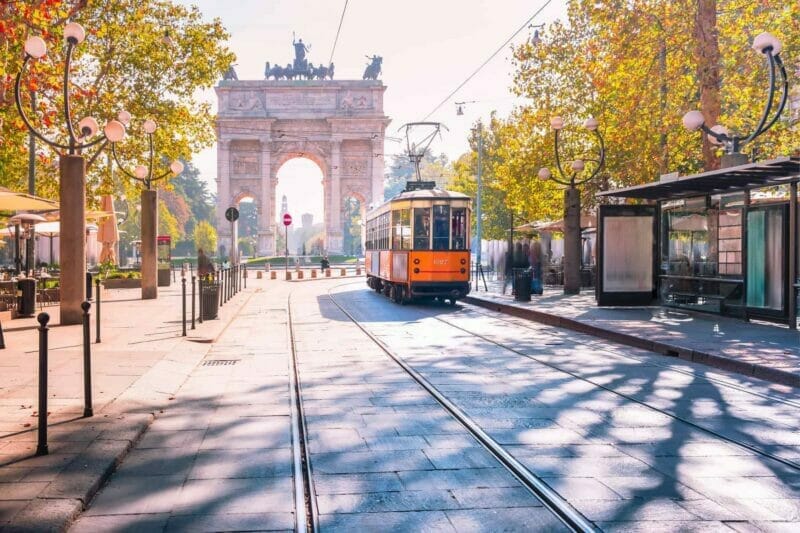
As with any big European city, Milan is chaotic, overpopulated, polluted, and features too much concrete.
However, for urban fans and foreigners looking for jobs, it offers a great lifestyle with all the amenities and public services, including international schools.
There are museums, exhibitions, cultural activities, and entertainment all year round. The restaurants and cafes offer food from all over the world.
Milan is extremely walkable, so many residents don’t own a car. In the city center, you can walk anywhere in the time it takes to find a parking space.
It’s easier to cycle or walk or use public transport.
Milan is well-connected internationally and to other areas of Italy. There are some fantastic lakes nearby, and ski slopes are not too far away either.
If you don’t want the 24/7 chaos of city life but still want to be within easy reach of Milan, try looking at some nearby places: Monza – 10 minutes by train, Varese – 54 minutes by train.
To find the most suitable area of Milan, read our Best Places To Live In Milan guide.
2. Lake Como – top retirement destination in Lombardy
If you are after a quieter and more serene life not too far from the buzz of Milan, head to Lake Como.
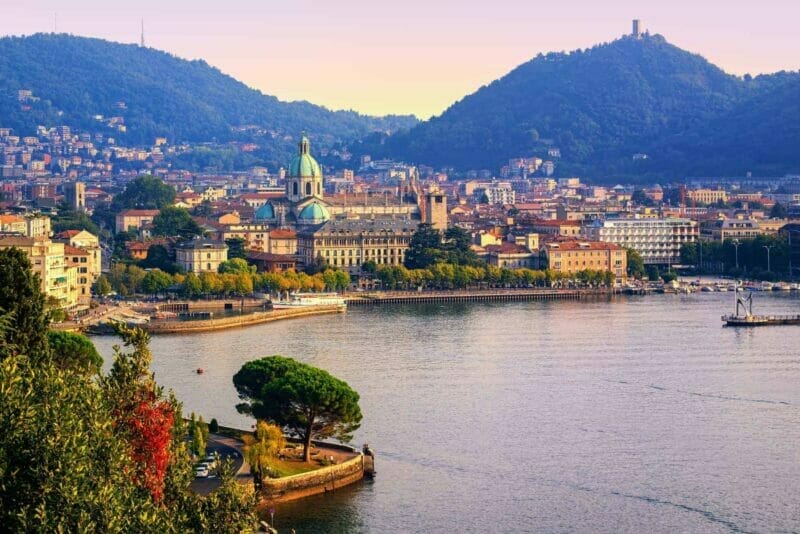
There are quite a few really lovely towns here that you can choose from, such as Colico, Lecco, Como, Varenna, Menaggio, and Bellagio.
The nearby Cernobbio, Torno, Blevio, and Moltrasio are becoming more popular with older expats.
The whole area is a great place for retirees. You live in a beautiful and scenic area, and all the major services are 15 minutes away by car.
Train connections to Milan, Varese, Lugano, Zürich, Basel, and Leccoare are good and reliable.
However, local services (buses and ferries) are reduced, so you might consider having a car for convenience.
In stark contrast to Milan, daily life here is simple: you can always take a walk on the lakeside and go to cafes downtown.
Don’t count much on entertainment, events, or exuberant nightlife, although the town center is full of lovely cafes, restaurants, and shops.
Here, you will find the most stunning and scenic walks you can ever find: the town’s narrow streets, lined with colorful buildings, lead you to an amazing promenade.
The nearby nature parks are all free of charge. The surrounding mountains are stunning. If you are into hiking, this is the right place.
There are also spectacular mountain bike trails, sailing, windsurfing, and kitesurfing.
Find out more in our Living in Como, Italy guide.
3. Bolzano – not very Italian but charming
Bolzano, together with Trento and Belluno, is among the best places to live in Italy for quality of life, according to the 2023 review conducted by ItaliaOggi in collaboration with La Sapienza University of Rome.
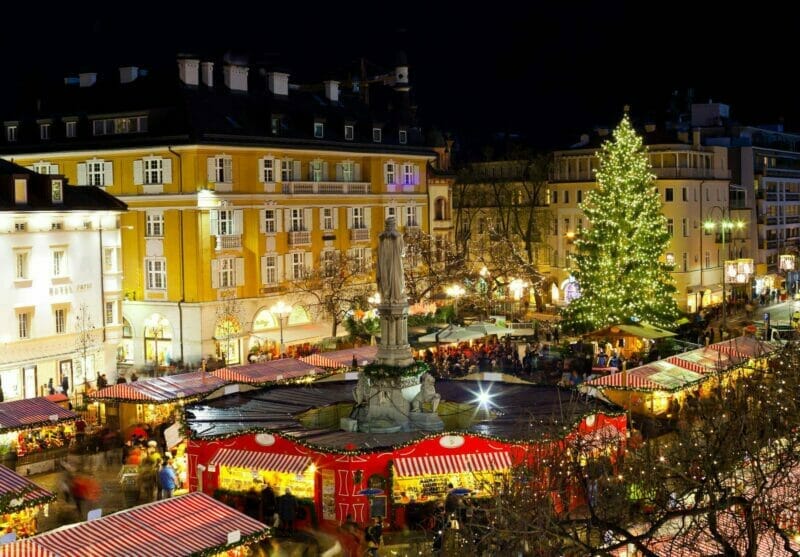
It’s a lovely medium-sized city in South Tyrol, northern Italy, with strong connections with Austria and Germany.
Many natives of Bolzano still have German and Austrian heritage. You can see it in architecture, food, lifestyle, and the fact that German is spoken alongside Italian.
Bolzano is brilliant for families or retirement. It’s peaceful, safe, quiet, and surrounded by the most beautiful mountains.
Being inland in the north, the region has distinct seasons.
In summer, Bolzano can get quite hot. In winter, it gets cold and snows a lot. If you like skiing, it’s the right place to be.
Around Bolzano, you can find small picturesque mountain villages, seemingly endless vineyards that produce very delicious local wines (some say it even beats Tuscany), a few castles, and the main feature – Italian Dolomites.
Bolzano itself has everything you need for a comfortable life: shops, cafes, restaurants, doctors, pharmacies, open markets, etc.
If you live in the town itself, you will have little need for a car. You can bike everywhere and move faster than if you were driving.
4. Trento – for a quieter urban life
As the capital of the Trentino region, Trento is bigger and a bit more urban than Bolzano.
It is also in South Tyrol, and so has quite a similar climate and environment.
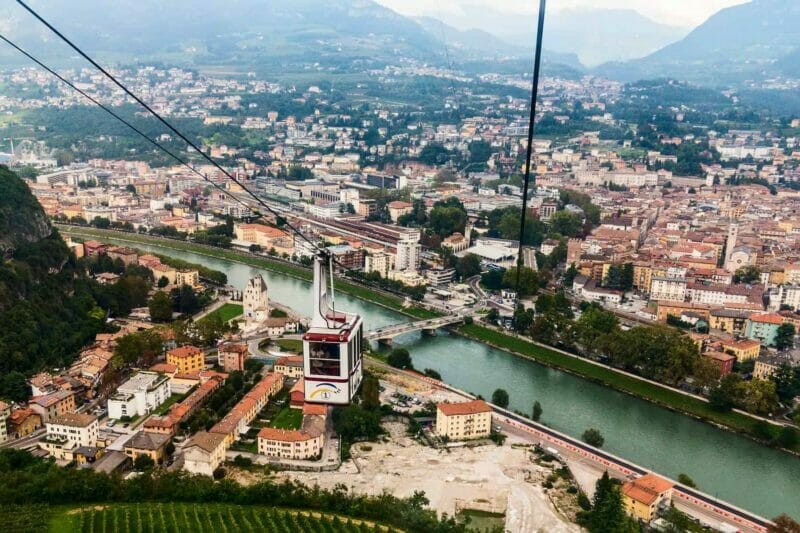
Trentino offers levels of well-being and quality of life that are among the highest in Europe.
It has an excellent educational system, a top-level health service, and a naturalistic heritage of extraordinary beauty.
Trento is nestled within the River Adige Valley – a stunning setting that’s home to one of the most picturesque cycling holidays in Europe.
The Adige Valley Cycle Path passes right through Trento.
It is an impressive 300 kilometers (186 miles) long and runs from Reschen am Reschensee all the way to Verona in the south.
Do you like active nightlife?
Then Trento is not for you.
Despite the fact that the city has a university that comes with a sizable youth population, it is well known for not having any nightlife after 8:00 PM.
This, of course, may be very appealing if you want a quiet urban-style retirement.
5. Brescia – young and vibrant
Brescia is an industrial hub with everything you’d expect to come with this.
It’s quite big on financial services, and a pretty sizable expat population lives and works there.

The city is well connected, both internationally and within Italy.
The airport of Milano Bergamo is very close, around 45 minutes by car, 1 hour by direct bus, or you can take a direct train and be in Brescia in 45 minutes.
Brescia has a beautiful promenade, lots of shops and boutiques, clubs and discos, and bars and cafes where Pirlo (a typical Italian aperitivo made with white wine, Campari, and seltzer) is a must before dinner.
You cannot get bored in Brescia; it has everything one needs for an active urban lifestyle. There’s even a miniature La Scala-type theatre.
If you wonder about the climate, it’s more continental, with cold winters and hot summers.
The lakes provide a beautiful retreat during the hot season, with Garda being not very far. It’s a very popular place to enjoy a weekend away doing watersports such as windsurfing and sailing or indulging in dolce niente (which basically means doing nothing).
Meanwhile, in winter, you can enjoy skiing, sledding, snow tubing, etc.
6. Liguria – mild weather all year round
Liguria, Italy’s western coastline stretching to Monaco, is an amazing location with its own microclimate thanks to the wall of mountains in the north and the sea in the south.
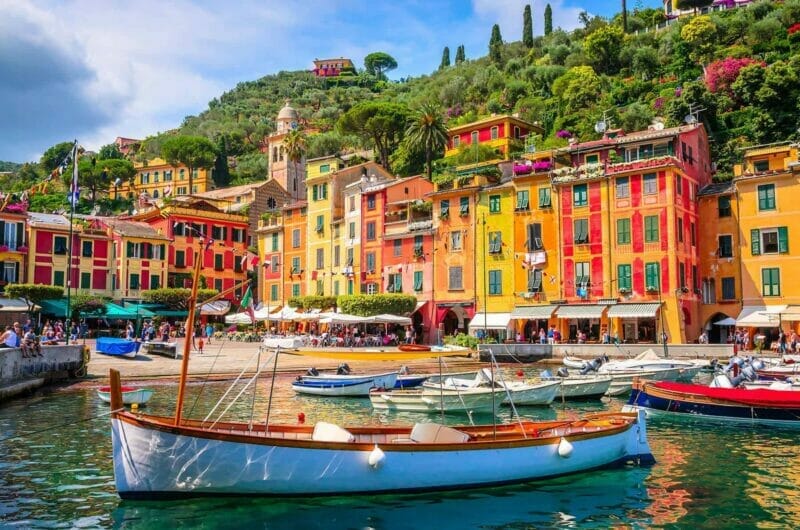
The Gulf Stream sends in warm weather, which is then trapped by the mountains.
You will never experience harsh temperature changes and will enjoy mild winters with warm temperatures and plenty of sunshine.
It is one of the 5 European destinations with great weather throughout the year. It is also the only Italian region with the Alps, Apennines, and the sea close together.
The small town of Portofino is probably the most famous destination in the region.
It’s breathtakingly beautiful and scenic. It’s uber-glamorous too and very expensive, just like the renowned Cinque Terre, a pretty destination featuring five old seaside villages.
If you don’t have deep pockets but cannot part with the dream of living here, head west from Genoa and look at the coast from Imperia to Genoa.
It is also a resort but a bit less discovered, so you might have a chance to acquire a lovely coastal home without breaking the bank.
7. Padua – affordable real estate
Venice is one of Italy’s brightest stars, no doubt. However, as we all know, it’s a flood risk, overwhelmed with tourists, and expensive.
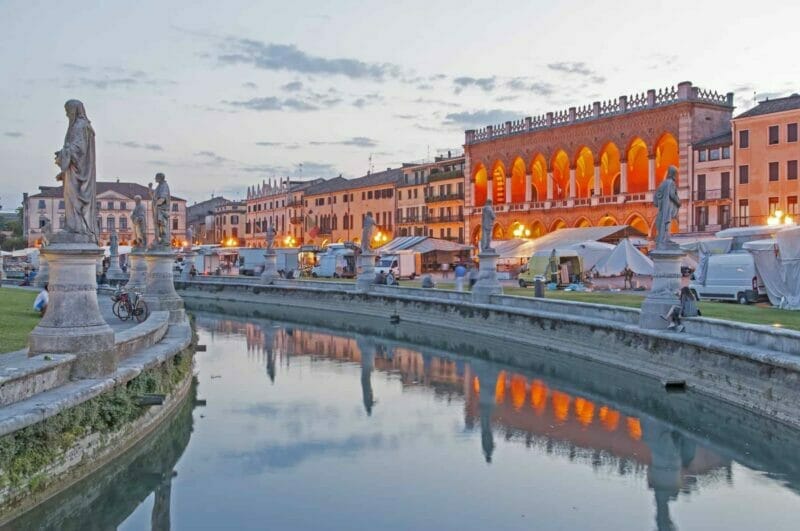
So, what would you say about moving to a smaller city 40 km away inland?
Padua (or Padova in Italian) is a quaint and beautiful city west of Venice in the Veneto region.
A short description of Padua is “affordable, walkable, livable and most importantly welcoming”.
The good news is that compared to many other Italian locations, the rent here is cheaper, and so are other things in general.
The city is full of craft beer places, as beer is a big thing in Padua. There are also lots of wines from the surrounding Colli Euganei and other Italian regions.
And, of course, there’s spritz!
The Geox Stadium and Theater attract big-name performers from all over the world, and there are always shows or events taking place.
Padua is quite compact, and it is easy to move within the city.
Everything that you might need is within walking distance. Bicycles and public transport are the main means of traveling if you don’t want to walk.
Padua is still well-connected, though. It’s close to Venice, just half an hour by train. This makes Venice’s Adriatic beaches your closest seaside.
For Padua residents, Venice is the main international gateway. The Marco Polo airport in Venice is just 20 kilometers (12 miles) east of Padua. It is conveniently linked with all major European airports.
8. Pisa – Tuscany’s underrated city
When it comes to living in Tuscany, there’s disagreement as to whether the best location is Florence, Lucca, or Pisa.
All three are amazing, and there’s little that can make one better than the others.
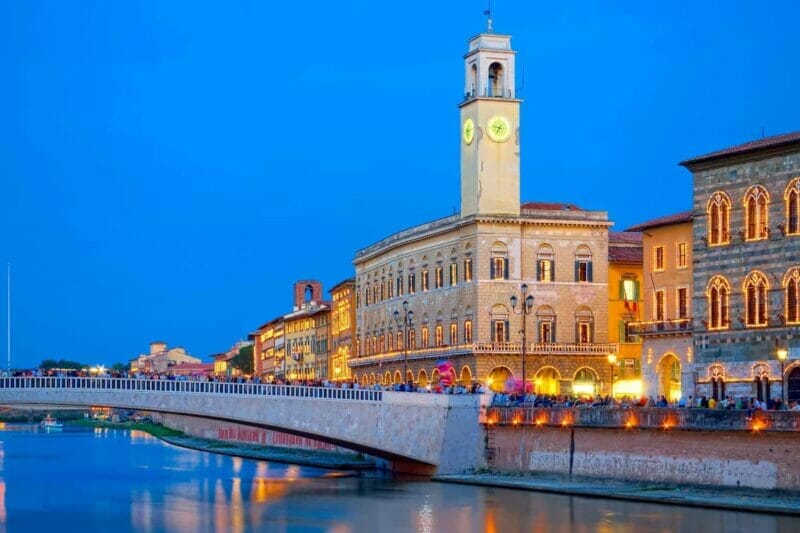
There is, however, one consideration that might put Pisa at the top of the list – the cost of living.
Both renting and buying a home are a bit more affordable in Pisa than in Lucca and much more affordable than in Florence.
Pisa is well connected – it is actually home to Galileo Galilei Airport, the largest airport in Tuscany.
Lucca and Livorno are just 20 – 30 min by car, and a high-speed train to Florence takes 49 minutes.
Pisa is much closer to the sea than Lucca or Florence.
It’s also next to the gorgeous Migliarino – San Rossore – Massaciuccoli Nature Park.
If you fancy a break at the seaside, there is a wonderful place called Marina di Vecchiano, 16 km away. It’s part of the Nature Park with sand dunes, pinewoods, and clear water.
The beach of Marina di Vecchiano is four kilometers of golden sand and low dunes and is an absolute joy to visit.
Pisa is not as grand or big as Florence. It’s actually quite small for a city, so you can easily get around on foot or by bike.
Cars feel obsolete in Pisa as everything is within walking distance, and the historic center of Pisa is a car-free zone anyway.
9. The Chianti area for laid-back expats
The Chianty in Tuscany is one of the most charming regions and one of the best places to live in Italy if you want to enjoy the Italian countryside.
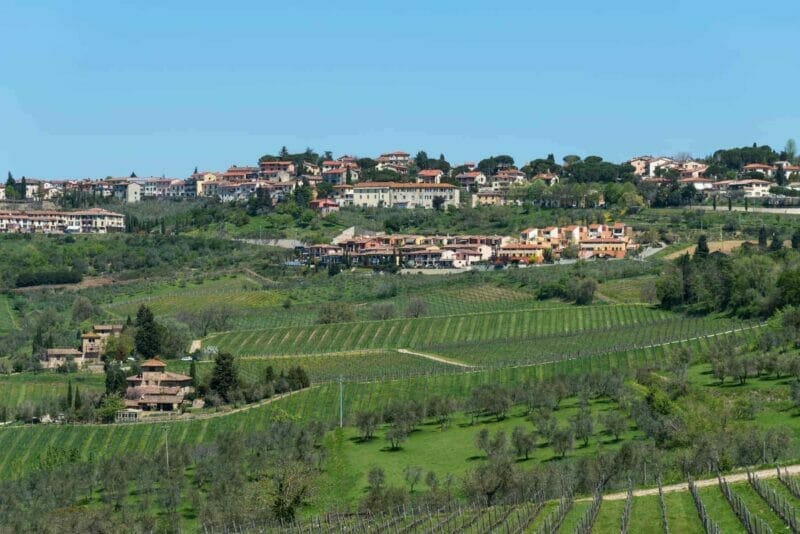
The Chianti is all about vineyards, olive groves, forests, medieval castles, and cozy hilltop villages, which provide peace and tranquillity for its residents.
Surprisingly, this rural type of living doesn’t scare off expats.
In the Chianti, you can find foreigners living happily, even in the smallest remote villages. Such popularity comes with a price, however: there is no really “affordable” location in the Chianti.
That said, many expats think it’s worth paying extra to enjoy the area’s natural and cultural riches.
In these small countryside places, you can live life the way Italians live – with the community at the heart of everything.
Being a part of the famous wine region, many local communities organize annual festivals to celebrate the vendemmia (the harvesting of grapes) – celebrations that attract visitors from all over the world.
Greve, a busy town near Florence, is quintessentially Italian and very attractive.
Its quaint triangular square and beautiful hills make it the perfect home for those looking for a calm and serene lifestyle.
18 km south of Greve, you will find Radda, another beautiful medieval town enclosed in large defensive walls.
Radda used to be the capital of the Chianti. It is close to major sites. It isn’t far from Florence to the north and Siena to the south.
Best places to live in the south
The southern regions of Italy, the ‘Mezzogiorno’, are sometimes dismissed by northern Italians and expats alike.
However, there are a lot of absolutely charming places around the south of Italy.
And although they might lack the northern sophistication, they more than make up for this with their beauty, warm climate, rich cultural heritage, and historic charm.
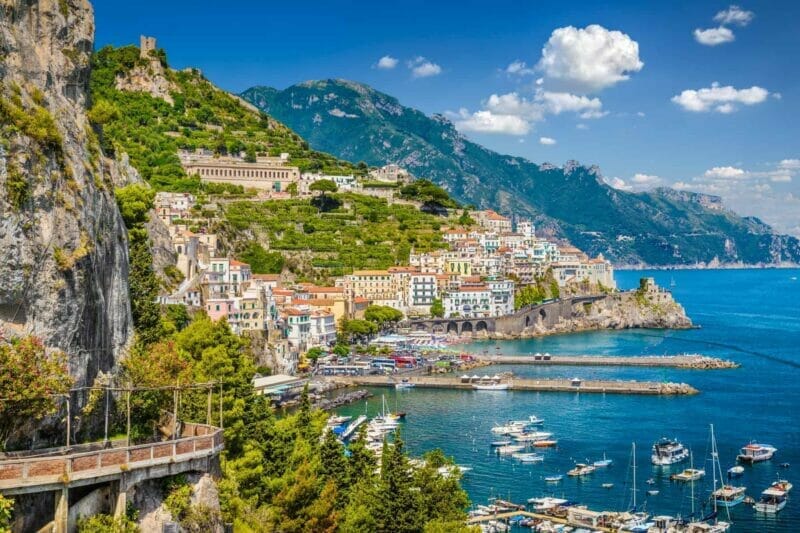
Those expats who have chosen southern Italy as their home say it has an energy and authenticity of culture that makes it so enticing.
Plus, expats choosing the south of Itlay can benefit from a 7% flat tax rate for 9 years.
The South is also more affordable than the North, especially real estate.
It is a fantastic region for retirement and digital nomads.
Check the available internet connection in your chosen location to ensure it’s what you need.
You might be surprised, but as one of our readers pointed out in the comments, sometimes you can find better internet quality in a small fishing village than in a big northern city.
10. The Amalfi Coast
The Amalfi Coast is a stunning 50-kilometer coastline along the Sorrentine Peninsula in the Campania region.
It stretches all the way between the port city of Salerno and the clifftop town of Sorrento.
The Amalfi coast features dramatic cliffs, tiny pebbly beaches, lovely fishing villages, impressive villas, terraced vineyards, and cliffside lemon groves.
The Amalfi coast is truly stunning, and for that reason, it’s a very popular tourist destination, with all the pros and cons that come with this.
In the winter season (from November until Easter), the coast is very quiet and sees hardly any visitors.
Hotels, bars, and restaurants are closed, and the streets, squares, and beaches become quiet.
Even in the midst of the winter, the weather is fairly mild; it gets warm for you to enjoy a lazy beach picnic.
The most popular locations on the Amalfi coast are Positano, Sorrento, and Amalfi.
Positano
Positano is a tiny town with quite an exclusive feel to it. It’s known as a vertical city, as it clings to the side of a steep mountain.
You may find that you can only reach your house from the road by climbing hundreds of steps up the hill.
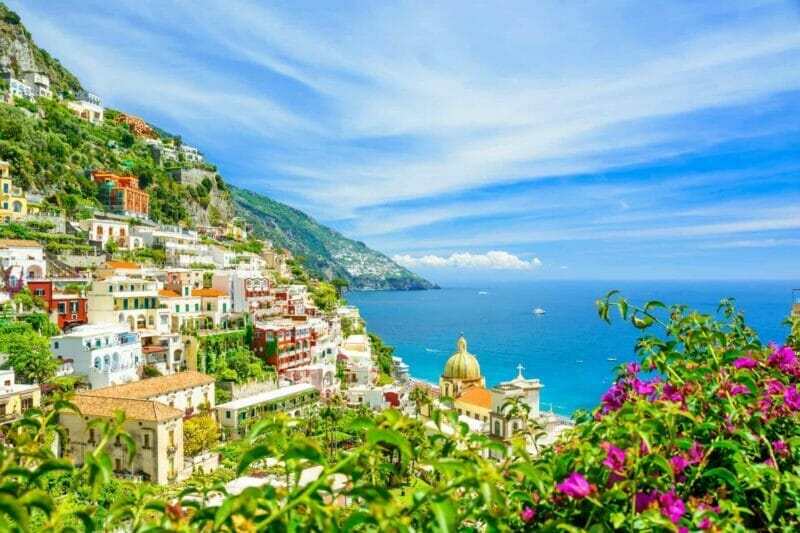
Positano is extremely popular among the wealthy and famous.
It’s centrally located and has a beautiful – if small – sandy beach and glamorous seaside bars, restaurants, and clubs. It’s also known for its upscale shopping.
Sorrento
Spectacularly positioned at the top of the cliff, Sorrento boasts magnificent views across the Bay of Naples.
When it’s fine and sunny, you can see all the way across to Naples itself, with Vesuvius looming over it.
Sorrento is a transport hub with railway, bus, hydrofoil, and ferry connections and all the services and amenities you need for a comfortable life.
But it comes with a hefty price tag – housing is pretty expensive here.
Don’t discard the location based on Sorrento’s real estate prices, though; look at the surrounding towns instead. They offer lower prices or at least better value for money.
Amalfi
Amalfi is the biggest town on the Amalfi Coast. It is located at the foot of Monte Cerreto and is surrounded by steep cliffs and a spectacular coastline.
The degree of exclusiveness is noticeably lower here than in Positano. It’s also somewhat cheaper and less crowded.
And yet, it’s stunningly beautiful. If you love arts, architecture, and glamorous events, Amalfi is where you want to be.
You will find all the extravagance and magnificence of Positano without the VIP cost.
11. South Sardinia – the best place to live in Italy for retirees
Sardinia, the second-largest island in the Mediterranean Sea, offers its residents the most hours of sunshine and the least rain in the whole of Italy.
Intrigued? Rightly so.
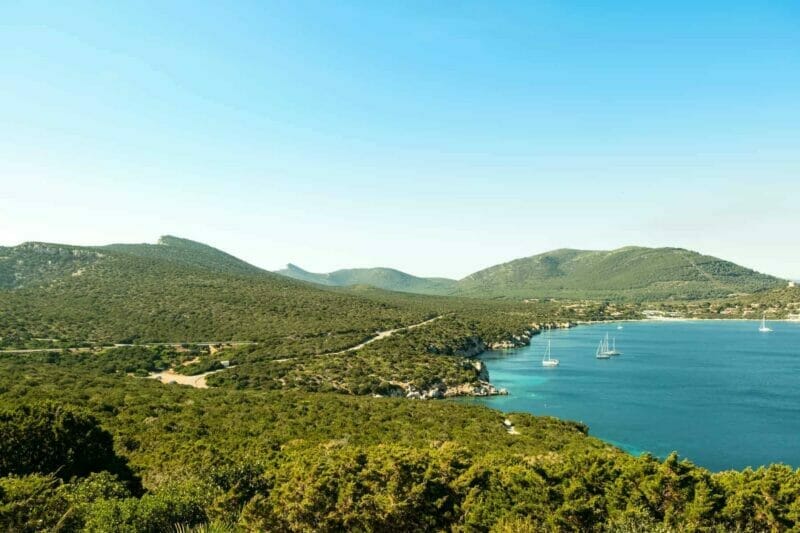
Sardinia has everything you want for a happy retirement: mild climate all year round, beautiful beaches, lower cost of living compared to major European cities, good healthcare, nature that encourages you to remain active, and nice food.
If you wonder how expensive it is to live in Sardinia, the answer will pleasantly surprise you: it’s quite affordable.
The south of Sardinia is especially sweet because it is dominated by a vast green plain called Campidano. It is also less crowded and cheaper than the North.
The coast is quite regular with a lot more sandy beaches.
Cagliari
Cagliari, the capital city of Sardinia, is located right in the middle of the southern coast.
The city’s cost of living is lower compared to other similar-sized cities in Italy.
It’s big enough to have everything in terms of entertainment and amenities: cinemas, opera theatres, shops, malls, supermarkets, pharmacies, clubs, bars, cafes, restaurants, and other necessary services.
Public transportation is decent. Trains connect downtown to the airport as well as other main cities on the Island, and buses to beaches and villages are available.
The atmosphere is very relaxed and calm, so if you come from a big city, you might find Cagliari potentially boring.
Both to the east and west of the city, there are beautiful beaches and lovely coastal locations that will take you away from city life while still offering proximity to all of Cagliari’s amenities.
Cagliari is very close to some of the most beautiful beaches in Sardinia, such as Villasimius (40 km), Mari Pintau (around 15 km), and Chia (50 Km), famous for their white sands and turquoise waters.
If you are seeking a quieter life, the surrounding countryside is a good place to consider.
If you drive northeast of Cagliari into the Sette Fratelli mountains (a national park), you will find lovely villages dotted along the first 30km.
House prices may pleasantly surprise you, and lots of new families are moving here.
It is lush and surrounded by trees and hills and only about 25 minutes by car to central Cagliari or the airport.
12. Rome – the most historic of the Italian cities
Out of all Italian cities, Rome, of course, stands out for its historic role.
Frankly speaking, Rome is not quite the right place to live if you crave a serene existence. It’s busy, overwhelmed with tourists, suffers from horrific traffic jams, and lacks efficient public transport.
The cost of living, especially rent and real estate, is terrifyingly high.
Yet, it feels impossible to omit the Eternal City from our list.
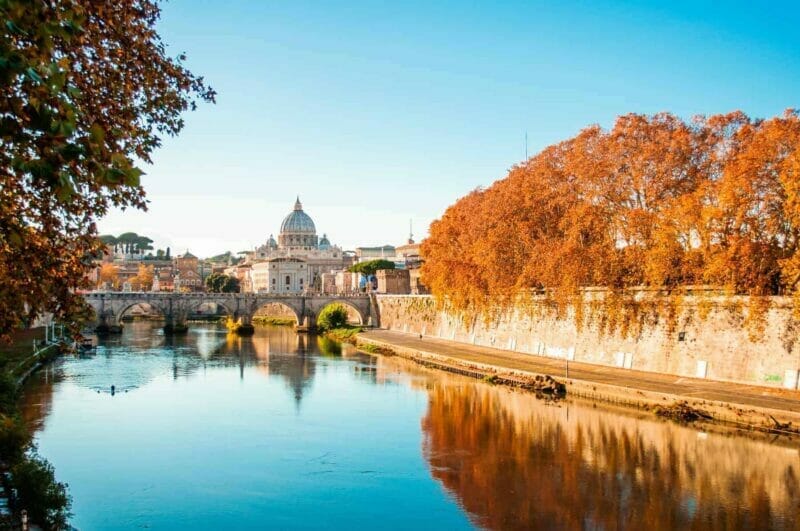
Rome is magnetic. It offers an exceptional atmosphere – full of historical references, a rich cultural environment, arts, and beautiful buildings. But it’s far from just an open-air museum.
Rome is a melting pot of everything Italian and beyond.
It is vibrant, vivid, and very cool and is definitely one of the best places to live in Italy if you are after something special.
Unlike many other cities, you don’t need to be wealthy to appreciate Rome’s lifestyle. It takes just a €2 gelato and a walk in the city center to enjoy it fully.
However, real estate here is not cheap.
Like in almost any other big city in the world, living in Rome is all about compromise.
Want to be within walking distance of all the coolest places in Rome?
Prepare to live in the smallest apartment possible and dump your car, as you won’t have anywhere to park it.
Want a larger living space?
You can find some modern and spacious (by Rome’s standards) apartments and even houses in the Parioli area or small satellite towns around Rome.
Relying on public transport, however, might be unwise.
There are just three metro lines in Rome, and the buses run on a pretty unreliable schedule. So, if you want to live outside of the center, make sure you have a good tram line nearby.
Rome is well-connected for national and international travel, making it convenient for frequent travelers. Regular trains can take you to Florence and Naples. You can use Eurostar to reach Milan in 4 hours.
There are regular flights from both airports: Fiumicino and Ciampino.
And you can take boats to Corsica, France, and Barcelona from the Civitavecchia port, which is about 80km away.
On the whole, Rome is fabulous, but living here might become tedious very soon, and you will be looking for something more liveable.
Find more information in our guide, Living In Rome.
Italy’s most popular locations – summary
There are so many brilliant places to live in Italy that it’s impossible to include them all in one guide.
There’s Sicily if you want an island living but for less money than in Sardinia; there’s Verona that punches above its weight culturally speaking; there is wonderful Bologna and the whole Emilia Romagna – one of the richest regions in Europe; there’s stunning Umbria largely untroubled by tourism, and many other fabulous locations.
Italy can become your perfect overseas home if you do the right research and choose a location that’s just right for you. So travel around, ask local expats, and don’t rush into buying a home.
Choose wisely, and you will find the lifestyle you’ve always wanted and enjoy la dolce vita for a long time.
You might find useful:
- Living In Italy – The Expats’ Essential Guide
- The Pros And Cons Of Buying Property In Sicily
- Didn’t find what you were looking for or need further advice? Contact us with your question, and we will do our best to help
Helpful external links:
- Discover real estate prices by region on the Immobiliare site.
- Moving to Italy with children? Here is a map of international schools.
- Discover which regions in the country rank well for the quality of life on the Sole 24 Ore site.
4 comments
Jon
I really enjoyed this. We’re seriously considering moving to Italy – we have a 1 and 2 year old and we figure now is the time to do it while they’re young. Pisa jumped off the page for me. Any shot you’d be willing to have a call to discuss your knowledge on it and other locations? no worries if not, and thank you again.
Ola Degteva
Hi Jon, probably, the best way will be to have a call with an Italy-based relocation advisor, if you wish to. We can put you in touch with a reputable service provider who can help organise every aspect of your move from research on the best areas to paperwork to legalities, etc. Thy charge for the orientation call, but the fee is moderate and serves as an assurance that the prospective client is serous and committed. If you are interested, get in touch with us via our contact page: https://expatra.com/contact/
All the best,
Gerry
Hmm would be best to edit out the “bad” internet access warning for southern italy. Here in Pioppi, a tiny fishing village of 300 souls 1.5 hrs south of amalfi we have 1gigabit fiber. Our friend’s loft in milan is stuck with 20 megabit dsl because none of the isp providers wants to dig up the road to lay fiber to their building there…
Ola Williamson
Thanks, Gerri, this is very helpful indeed.